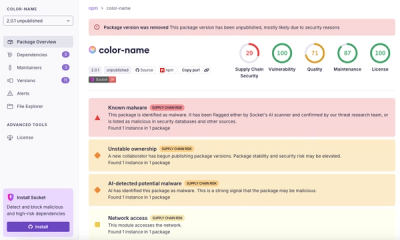
Product
Introducing Pull Request Stories to Help Security Teams Track Supply Chain Risks
Socket’s new Pull Request Stories give security teams clear visibility into dependency risks and outcomes across scanned pull requests.
inline-markdown-editor
Advanced tools
An inline wysiwyg markdown document editor based on replacing string subsections. WYSIWYG possible via woofmark.
An inline wysiwyg markdown document editor based on replacing string subsections. WYSIWYG possible via the woofmark-based PublicLab.Editor.
inline-markdown-editor splits up a Markdown-containing string by double newlines into sections, and parses each into HTML, which it displays.
It then adds an "edit button" beneath each section, which expands a nice form for editing that section either as Markdown or in rich text with a WYSIWYG editor.
Upon submitting the form, an asynchronous AJAX post request is made to the specified server with parameters before and after, containing the original subsection markdown and its replacement. The form listens for a true or false response and updates the section's displayed HTML accordingly.
For a demo, see:
https://publiclab.github.io/inline-markdown-editor/examples/
https://publiclab.github.io/inline-markdown-editor/examples/wysiwyg
For an easy start, you can begin using inline-markdown-editor by pointing it at a markdown-containing element by its selector, and specifying a URL to send changes to.
inlineMarkdownEditor({
replaceUrl: '/wiki/replace/',
selector: '.markdown'
});
You can also specify filters to run on the raw original markdown before display, and afterwards upon the displayed DOM element, as well as override several other defaults:
inlineMarkdownEditor({
replaceUrl: '/wiki/replace/' + wiki_id,
selector: '.markdown',
preProcessor: function preProcessMarkdown(markdown) {
// do things to markdown here before it's used to construct the form
return markdown
},
postProcessor: function postProcessContent(element) {
// do things to element here after the section has been converted to HTML and displayed
},
defaultMarkdown: function(markdown) {}, // a markdown parser
buildSectionForm: function() {}, // return a string containing the form element
onComplete: function(response, markdown, html, el, uniqueId, form, o) {}, // run on completing AJAX post
isEditable: function(markdown) {}, // returns boolean; whether a given subsection should get an inline form; default skips HTML and horizontal rules
extraButtons: { 'fa-icon-name': function(element) {} }, // object with keys of icon names for additional buttons with associated actions for each; returns jQuery element upon construction
submitSectionForm: function(event, before, after, options) {}, // optional, to override the form submission handling for each subsection; before/after represent the text diff
editorOptions: {} // any options to pass to the built-in PublicLab.Editor instance
});
To install this library for development, you'll need NodeJS. You can get the detailed instruction on installing node and npm in its official documentation.
After installing node and npm run npm install from the root directory.
inline-markdown-editor uses grunt - the JavaScript task runner - for compilation of the modules. To install grunt run npm install -g grunt-cli. You may have to use sudo for root privileges.
Make changes to the files in the /src/ directory, then run grunt build to compile into /dist/inlineMarkdownEditor.js. This will use grunt-browserify to concatenate and include any node modules named in require() statements. You'll then be able to try it out in /examples/index.html. Run grunt and leave it running to build as you go.
Tests are set up with Jasmine, and can be run with npm test.
FAQs
An inline wysiwyg markdown document editor based on replacing string subsections. WYSIWYG possible via woofmark.
The npm package inline-markdown-editor receives a total of 23 weekly downloads. As such, inline-markdown-editor popularity was classified as not popular.
We found that inline-markdown-editor demonstrated a not healthy version release cadence and project activity because the last version was released a year ago. It has 1 open source maintainer collaborating on the project.
Did you know?

Socket for GitHub automatically highlights issues in each pull request and monitors the health of all your open source dependencies. Discover the contents of your packages and block harmful activity before you install or update your dependencies.

Product
Socket’s new Pull Request Stories give security teams clear visibility into dependency risks and outcomes across scanned pull requests.

Research
/Security News
npm author Qix’s account was compromised, with malicious versions of popular packages like chalk-template, color-convert, and strip-ansi published.

Research
Four npm packages disguised as cryptographic tools steal developer credentials and send them to attacker-controlled Telegram infrastructure.